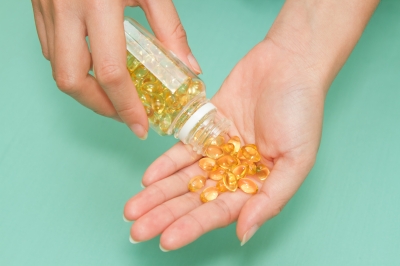High Fiber Diet Plan to Lower Cholesterol and Lose Weight

Do you have high cholesterol? Increase your fiber!
Do you have high blood pressure? Increase your fiber!
Are you overweight? Increase your fiber!
What is it with fiber (also known as roughage)? It seems to play a role in just about all our health problems. Well, as far as blood pressure and cholesterol go, dietary fiber binds to cholesterol in circulation and helps remove it from the body. Research has shown that for every 1-2 grams of daily soluble fiber intake, LDL (bad) cholesterol is lowered 1%.
On the weight control side of things, a high fiber diet plan increases satiety (how full you feel), aiding efforts to lose weight and/or maintain a healthy weight.
4 Things You Need to Know to Use Dietary Fiber to Lower Cholesterol:
1. There are two types of fiber.
Fiber Insoluble
Insoluble fiber remains relatively intact as it passes through the digestive system. The primary function of insoluble fiber is to move waste through the intestines and maintain intestinal acid balance.
Fiber Soluble
Soluble fiber is the type of fiber responsible for lowering total cholesterol and LDL (bad) cholesterol levels.
2. Sources of insoluble fiber
Fruit skins and root vegetable skins
Vegetables (green beans, celery, cauliflower, zucchini, beets, turnips, potato skins, and dark green leafy vegetables)
Wheat and whole-wheat products
Wheat oats
Corn bran
Seeds and nuts
3. Sources of soluble fiber
Oat and oat bran
Legumes (dried beans and peas)
Nuts
Barley, rye
Flaxseed
Fruits (i.e. oranges, apples, prunes, plums, berries)
Vegetables (i.e. carrots, broccoli, potatoes, sweet potatoes, onions)
Psyllium husk
Shoot for 25-35 grams of dietary fiber everyday. Of this fiber, soluble fiber should make up 15 grams. The average US dietary fiber intake is 12-18 grams/day.
If your current diet is very low in dietary fiber, don’t increase to 35 grams overnight. A sudden increase will result in gastrointestinal (stomach) distress and unpleasant side effects (flatulence and diarrhea). You want to increase your fiber intake gradually.
Bottom Line:
Select high fiber foods, especially foods that contain soluble fiber. I once heard a gastroenterologist say he would be out of a job if everyone just ate more beans!
February is American Heart Month. In recognition of American Heart Month you can access Heart Health Made Easy at a 25% savings. Learn more about this take action guide to lower cholesterol and blood pressure at http://www.hearthealthmadeeasy.com.
All the best,
Lisa Nelson RD
Lower Cholesterol – Do you need to treat a low HDL level?
Here’s another question I asked Dr. Cynthia Shelby-Lane and her answer.
Lisa Nelson RD: Should individuals with low HDL levels receive treatment even if all other levels are normal?
Dr. Shelby-Lane: According to ScienceDaily (May 29, 2005) — High circulating levels of the “good cholesterol” HDL are associated with decreased risk of cardiovascular disease. HDL helps the liver excrete extra cholesterol by binding to a receptor in the liver called scavenger receptor-BI (SR-BI). However, the signaling events between HDL and SR-BI that afforded heart healthy benefits were not known.
In a study appearing online on March 24, 2005, in advance of the April 1, 2005 print edition of the Journal of Clinical Investigation, Philip Shaul and colleagues from the University of Texas Southwestern Medical Center examine the following pathway:
The authors show that HDL activates an enzyme called eNOS and sets off a cellular signal that depends on cholesterol efflux and two intact domains of SR-BI — the transmembrane domain and its cytoplasmic tail. These regions of SR-BI may serve as “cholesterol sensors” which set into motion cellular events to activate eNOS. This may be the mechanism responsible for the ability of HDL to reduce cardiovascular disease risk.
Lisa Nelson RD: Again, let’s clarify. If an individual has low HDL levels they should seek treatment even if all other cholesterol levels are normal. Correct? Correct?
Dr. Shelby-Lane: Again, a low HDL is an isolated risk factor and should be included in the overall health picture, and can be modified with diet, nutrition, and some newer drugs.
February is American Heart Month. In recognition of American Heart Month you can access Heart Health Made Easy at a 25% savings. Learn more about this take action guide to lower cholesterol and blood pressure at http://www.hearthealthmadeeasy.com.
All the best,
Lisa Nelson RD
How to Lower Cholesterol in 8 Simple Steps
Heart Health – Is fish oil safe?

Fish oil supplements are a great alternative for people that do not eat fish often to boost their omega 3 intake and promote heart health.
There’s been some media speculation about possible contaminants, such as mercury, within fish oil supplements. However, good news if you supplement fish oil, there are minimal contaminants within the supplements!
There have been several studies, specifically a report by ConsumerLab.com and Harvard Medical School, finding no mercury or PCBs within over 40 popular fish oil supplements. Fish oil is typically taken from fish, such as cod and sardines, that do not contain high levels of mercury. Also, many manufacturers distill the fish oil to remove contaminants.
All the best,
Lisa Nelson RD
Image courtesy of Praisaeng / FreeDigitalPhotos.net
Lower Cholesterol – Top Omega 3 Sources to Lower Cholesterol
If you have been following along, you know from the article "Get a Grip on Fatty Acids" that the right ratio of omega 6 to omega 3 fatty acids promotes a lower cholesterol.
The goal is not to cut omega 6 fatty acids (such as corn oil, beef, and chicken) completely from the diet, but to achieve a ratio of 4:1 or 1:1 omega 6 to omega 3. In order to attain this ratio you need to increase your omega 3 intake.
Your options for doing this:
1. Eat fish at least twice a week.
If you like fish, this would be my first choice. Fish contains DHA. Research is starting to indicate health benefits, such as lower cholesterol, lower triglycerides, and higher HDL (good) cholesterol, linked to DHA alone. Be aware of mercury content of fish, especially if you are pregnant.
2. Take a fish oil supplement.
Start with the smallest bottle you can find and make sure you do not have the unpleasant side effect of burping with a fishy aftertaste. Not everyone has this problem, so you may be fine. To decrease likelihood of this problem I recommend taking the supplement and then eating. That way something is "on top" of the fish oil. Fish oil has a tendency to go rancid, so keep supplement refrigerated, especially if you buy a bottle of 250 or more.
3. Flaxseed.
You can buy flaxseed two different ways – whole seed or ground. In order for the body to utilize the omega-3 fatty acids, flaxseed must be ground. If the flaxseed is not ground it passes straight through the body without being absorbed. Flaxseed is high in fiber, so by ingesting whole flaxseed you have increased your fiber intake, which is beneficial, but if you grind your flaxseed you will have the added benefit of increasing your omega-3 fatty acid intake and lowering cholesterol.
4. Flaxseed oil supplement.
Provides the omega 3 fatty acid ALA in a simple supplement. Now, ALA is not as effective as DHA and EPA at lowering cholesterol, but still results in an improved ratio of omega 3 to omega 6. Again, may go rancid so refrigerate.
5. Add omega 3 nut and seed sources to your daily intake.
Especially walnuts, pumpkin seeds, Brazil nuts, and sesame seeds. Nuts are high calorie, so watch your intake. If you gain weight, you are not doing your heart any favors!
Access the ecourse How to Lower Cholesterol in 8 Simple Steps HERE.
All the best,
Lisa Nelson RD
Reduce Heart Disease – What are the benefits of supplementing CoQ10?
The benefits of CoQ10 are numerous:
- Prevent heart disease
- Slows the aging process
- Lowers blood pressure
- Boosts energy
- Increases strength
- Builds up the immune system
- Improves the nervous system
- Protects against gum disease
- Counteracts negative side effects of some cholesterol medications
Consult your MD to determine if supplementing CoQ10 is the right treatment option for your situation.
February is American Heart Month. In recognition of American Heart Month you can access Heart Health Made Easy at a 25% savings. Learn more about this take action guide to lower cholesterol and blood pressure at http://www.hearthealthmadeeasy.com.
All the best,
Lisa Nelson RD
 |
Omega Q Plus supports:
|
Reduce Heart Disease – Do you know the signs of a CoQ10 deficiency?
Symptoms associated with a CoQ10 deficiency develop gradually over time, so it’s very easy to miss the signs.
Symptoms include: aches and pains, fatigue, sore muscles, weakness, malaise, and shortness of breath
Our bodies are designed for CoQ10 to be formed from a variety of vitamins, minerals, and amino acids. If your intake of vitamin C, B-12, B-6, pantothenic acid, and various other minerals and nutrients is deficient, the production of CoQ10 is compromised. Conditions and medications, such as hyperthyroidism, antidepressants, gum disease, and advanced age will also cause lower than adequate levels of CoQ10.
All the best,
Lisa Nelson RD
 |
Omega Q Plus supports:
|



